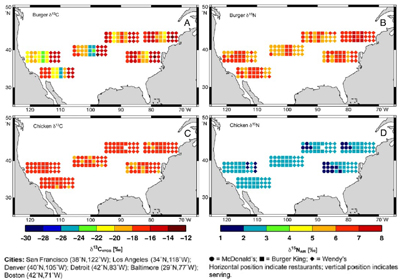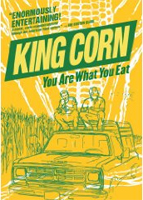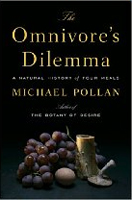American fast food is almost entirely made of corn
mongabay.com
November 10, 2008
Study also shows that fast food restaurants are misleading consumers about the oils they use to cook their food products.
|
|
American fast food is almost entirely produced from corn according to a chemical analysis of dishes served at McDonald’s, Burger King, and Wendy’s. The study is published in the journal Proceedings of the National Academy of Sciences.
Using a stable isotope analysis of carbon and nitrogen to determine the origin of molecules present in hamburgers, chicken, and fries, Hope Jahren and Rebecca Kraft found corn to be the almost exclusive food source of the beef and chicken served in fast food restaurants. The researchers also uncovered evidence to suggest that fast food restaurants are misleading consumers as to the oils used in preparing french fries and that animals slaughtered for production are kept in confined quarters, rather than outdoors.
The authors say the finding that fast food restaurants are not accurately reporting their sources of oils, lends support for legislation mandating ingredient labeling for fast food. Presently ingredient reporting is a “voluntary and seldom-invoked” process.
“Fastfood corporations, although they constitute more than half the restaurants in the U.S. and sell more than 1 hundred billion dollars of food each year, oppose regulation of ingredient reporting,” the authors write. “Ingredients matter for many reasons: U.S. corn agriculture has been criticized as environmentally unsustainable and conspicuously subsidized.
“Of 160 food products we purchased at Wendy’s throughout the United States, not 1 item could be traced back to a noncorn source. Our work also identified corn feed as the overwhelming source of food for tissue growth, hence for beef and chicken meat, at fast food
restaurants.”
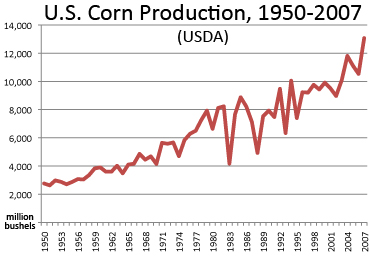 U.S. Corn production, 1950-2007 |
The idea that corn — and its derivatives — is increasingly the basis of the American diet has recently been popularized in Michael Pollan’s book The Omnivore’s Dilemma and the film King Corn. A diet consisting of fast food and products with high fructose corn syrup — including soda, which was excluded from the PNAS study — has been blamed by nutritionists for contributing to rising rates of obesity and diabetes in the United States as well as other health problems, including heart disease.
Making consumers aware of the source of their food is a critical first step to improving the American diet, say Jahren and Kraft.
“Our work highlights the absence of adequate consumer information necessary to facilitate an ongoing evaluation of the American diet,” they conclude.
CITATION:
A. Hope Jahren and Rebecca A. Kraft. Carbon and nitrogen stable isotopes in fastfood: Signatures of corn and confinement. PNAS Early Online Edition for the week of Nov. 10-14, 2008.
King Corn (DVD)
KING CORN is a fun and crusading journey into the digestive tract of our fast food nation where one ultra-industrial, pesticide-laden, heavily-subsidized commodity dominates the food pyramid from top to bottom corn. Fueled by curiosity and a dash of naivete, college buddies Ian Cheney and Curt Ellis return to their ancestral home of Greene, Iowa to figure out how a modest kernel conquered America. With the help of some real farmers, oodles of fertilizer and government aide, and some genetically modified seeds, the friends manage to grow one acre of corn. Along the way, they unlock the hilarious absurdities and scary but hidden truths about America s modern food system in this engrossing and eye-opening documentary. | The Omnivore’s Dilemma: A Natural History of Four Meals
The bestselling author of The Botany of Desire explores the ecology of eating to unveil why we consume what we consume in the twenty-first century. Today, as America confronts what can only be described as a national eating disorder, the omnivore’s dilemma has returned with an atavistic vengeance. The cornucopia of the modern American supermarket and fast-food outlet has thrown us back on a bewildering landscape where we once again have to worry about which of those tasty-looking morsels might kill us. At the same time we’re realizing that our food choices also have profound implications for the health of our environment. The Omnivore’s Dilemma is bestselling author Michael Pollan’s brilliant and eye-opening exploration of these little-known but vitally important dimensions of eating in America. |
Related articles
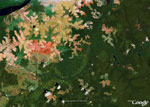 |
Why is palm oil replacing tropical rainforests?
(4/25/2006) In a word, economics, though deeper analysis of a proposal in Indonesia suggests that oil palm development might be a cover for something more lucrative: logging. Recently much has been made about the conversion of Asia’s biodiverse rainforests for oil-palm cultivation. Environmental organizations have warned that by eating foods that use palm oil as an ingredient, Western consumers are directly fueling the destruction of orangutan habitat and sensitive ecosystems. So, why is it that oil-palm plantations now cover millions of hectares across Malaysia, Indonesia, and Thailand? Why has oil palm become the world’s number one fruit crop, trouncing its nearest competitor, the humble banana? The answer lies in the crop’s unparalleled productivity. Simply put, oil palm is the most productive oil seed in the world. A single hectare of oil palm may yield 5,000 kilograms of crude oil, or nearly 6,000 liters of crude.
 |
U.S. ethanol may drive Amazon deforestation
(5/17/2007) Ethanol production in the United States may be contributing to deforestation in the Brazilian rainforest said a leading expert on the Amazon. Dr. Daniel Nepstad of the Woods Hole Research Center said the growing demand for corn ethanol means that more corn and less soy is being planted in the United States. Brazil, the world’s largest producer of soybeans, is more than making up for shortfall, by clearing new land for soy cultivation. While only a fraction of this cultivation currently occurs in the Amazon rainforest, production in neighboring areas like the cerrado grassland helps drive deforestation by displacing small farmers and cattle producers, who then clear rainforest land for subsistence agriculture and pasture.
Corn ethanol is worsening the Gulf dead zone
(3/10/2008) Proposed legislation that will expand corn-ethanol production in the United States will worsen the growing “dead zone” in the Gulf of Mexico and hurt marine fisheries, report researchers writing in the Proceedings of the National Academy of Sciences (PNAS).
U.S. biofuels policy drives deforestation in Indonesia, the Amazon
(1/17/2008) U.S. incentives for biofuel production are promoting deforestation in southeast Asia and the Amazon by driving up crop prices and displacing energy feedstock production, say researchers.
 |
World’s only blue lizard heads toward extinction
(3/7/2007) High above the forest floor on the remote Colombian island of Gorgona lives a lizard with brilliant blue skin, rivaling the color of the sky. Anolis gorgonae, or the blue anole, is a species so elusive and rare, that scientists have been unable to give even an estimate of its population. Due to the lizard&spod;s isolated habitat and reclusive habits, researchers know little about the blue anole, but are captivated by its stunning coloration.
